Andrew Paul Wood – 16 September, 2011
Biomorphism reflects a preference for ambiguous and organic shapes, drawing particularly on nature and anatomy to capture and express the vital life-force to liberate art from the constraints of technocratic civilisation. This does not strictly apply to Akehurst's objects. Their ambiguous forms suggest the power of the individual imagination to transcend the mundane world - or at least art history.
Before postmodernism made it extinct, the bohemian pretentions of the avant-garde’s death rattle (second or third hand from the School of Paris at that) left it wide open to parody by a bilious establishment. The trouble was that the people doing the parodying (one thinks of the British cartoonist Giles (Ronald “Carl” Giles, 1916-1995), or the hoax movement of the Disumbrationists established in 1924 - both usually mocking surrealism) were invariably themselves too artistic to bring themselves to do a bad job; the result often more accomplished than the object of their scorn.
Matt Akehurst’s Object (part of the larger show Feeding Time) at ABC gallery in Addington - one of the industrial suburbs jostling for position of Christchurch’s new arts precinct - is obviously a caricature of mid-twentieth century modernism, but nonetheless tinged with a copybook nostalgia and gentle bonhomie. You couldn’t call it reverent as such, but neither is it mean spirited or uncurious about its sources. It is ironic facsimile modernism, which is kinda appropriate when you consider that precious few New Zealand artists got to see actual European modernism when it was fresh out of the oven.
Akehurst’s correction fluid-white biomorphic blobs, in vitrines on plinths no less, press all of the traditional art gallery buttons, but ring just false enough to let you know it isn’t serious. Recall the blobby white shape-shifting Schmoo created by American cartoonist Al Capp (1909-1979), which first appeared in his classic comic strip Li’l Abner in 1948. Then take your Schmoo to an art museum and show it Arp, Hepworth, Sutherland, Noguchi, Moore, and maybe even some Bourgeois. Like pulp horror writer H.P. Lovecraft’s amorphous Shuggoth, they seem to be in a constable state of mutability, paused in freeze-frame for our delectation:
It was a terrible, indescribable thing vaster than any subway train-a shapeless congeries of protoplasmic bubbles, faintly self-luminous, and with myriads of temporary eyes forming and un-forming as pustules of greenish light all over the tunnel-filling front that bore down upon us, crushing the frantic penguins and slithering over the glistening floor that it and its kind had swept so evilly free of all litter. (H. P. Lovecraft, ‘At The Mountains of Madness’, 1931)
Objects. Sculptures, even. In an art gallery. Scandalous. And yet Akehurst’s objects function perfectly well as object in their own right, full of charm, endearingly cute, but fully grounded in sculptural sensibilities. The precedents are, perhaps, primarily to be found in painting: Philip Guston, Elizabeth Murray, and closer to home Mark Braunias and Rob McLeod- the forms are bulbous, abstract and cartoon-like, not without a certain eroticism and anxiety. The circular mouths could coo like babies or existentially shriek like Munch’s Scream (1893-1910), nor are they entirely different from the horror mask in that other famous Scream - the 1996 Hollywood movie. Other cinematic references that come to mind are the watery aliens in The Abyss (1989) and the tortured permutations of the quicksilver metamorph T-1000 “dying” in the molten metal at the end of Terminator II (1991) - both spawned by the then new morphing CGI technology. Akehurst’s sculptures, on the other hand, are reassuringly static, despite curving and bulging with a life of their own.
Biomorphism, taken at face value reflects a preference for ambiguous and organic shapes, drawing particularly on nature and anatomy to capture and express the vital life-force to liberate art from the constraints of technocratic civilisation. This, I think, does not strictly apply to Akehurst’s objects. Their ambiguous forms, however, like biomorphism, suggest the power of the individual imagination to transcend the mundane world - or at least art history.
Some artists and art historians have tried to make a case for modernism being simply one genre among many - a subset of classicism, romanticism’s final hurrah, or, paradoxically, both (anything is possible in postmodernism) - and that may be the sentiment expressed in this work. It’s impossible to say for sure. What is clear, however, is that the artist clearly enjoyed making these self-indulgent little amusements.
Andrew Paul Wood
Recent Comments
Andrew Paul Wood
All things are lawful for me, but all things are not expedient: all things are lawful for me, but all ...
John Hurrell
Koons and Warhol are generally considered unironic, Andrew. Most commentators would agree I'm confident. As for art historical categories, surely ...
David Cauchi
Highly dubious, I say! Ha ha ha.
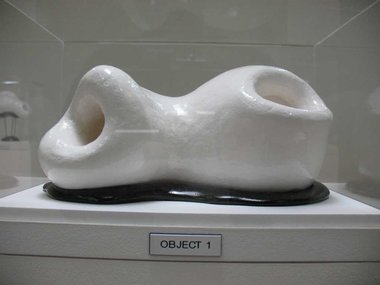

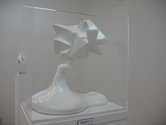

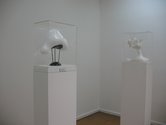
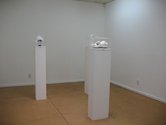
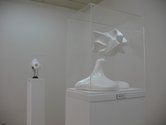
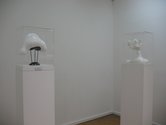
 Advertising in this column
Advertising in this column Two Rooms presents a program of residencies and projects
Two Rooms presents a program of residencies and projects



This Discussion has 35 comments.
Comment
Roger Boyce, 4:29 p.m. 16 September, 2011 #
I'd add Ken Price http://tiny.cc/gebks to the list of potential visual analogs.
Nice & tight bit of text Mr.P.W.
Owen Pratt, 11:12 a.m. 19 September, 2011 #
Perhaps the mid century modernist style was already a pastiche of the biomorphic blobjects created some decades and a world war earlier. That said these crude forms look like maquettes for the Opunake concrete adventure playground C.1972.
More travesty than parody.
Andrew Paul Wood, 1:13 p.m. 19 September, 2011 #
Mid-century modernism almost certainly was a pastiche of earlier blobomorphic art. If they also suggest maquettes for 1970s adventure playgrounds, I think that's great - it adds to the work for me. They are supposed to be crude and awkward, as I read them, much like most mid-century New Zealand modernism. Have you actually seen the work in the flesh? If you haven't, I don't think judging them "More travesty than parody" is justifiable.
Owen Pratt, 1:25 p.m. 19 September, 2011 #
So which era is this a parody of ? and if its a joke its a bit late and not very funny.
Have you seen the work all of the modernists that are supposed to be turning in their graves because of this surgical but flinty humour? If not then perhaps it is unwise to compare.
Andrew Paul Wood, 5:33 p.m. 19 September, 2011 #
Owen, you're reading the work as though it were an attack on modernism - I don't think it is. It seems to me more like an affectionate jibing. Nor do I think any specific period is intended - biomorphism was a fairly dominant trope in art and design throughout the twentieth century, and even now judging from the way Apple products look. Yes, I have seen the work of all of the artists I have cited, and I'm not comparing - I'm setting us a background context.
Owen Pratt, 9:06 a.m. 20 September, 2011 #
Yes you are right I do see this as an attack on the artists you list, which is perfectly legitimate but a bit like pulling the wings off butterflies. As for affectionate jibing Akehurst doesn't have the skill for this; it is just crude. As crude as the legions of failed sculpture students who have poorly attempted to imitate the complexity of those sculptors over the past 70 years. Crude jibing is an attack not irony.
If you have experienced Arp's plaster sculpture and can still say this work is ironic then I will pass the diagnosis of ADD that R.Boyce attributes to me, on.
Andrew Paul Wood, 6:14 p.m. 23 September, 2011 #
I take it you are unfamiliar with concepts like "banter", "guest roasts" and "best man speeches" then. All friendly ribbing when observed in the correct context.
Owen Pratt, 7:07 p.m. 23 September, 2011 #
Best man speech? More like fart jokes in the eulogy.
John Hurrell, 1:46 p.m. 19 September, 2011 #
If Matt's work is a satire it is not self evident, but needs a cue - some visual 'key' that declares to the viewer 'don't take this at face value.' I'm alluding here to Wayne Booth's over-arching theory in his 'A Rhetoric of Irony'. It is I think a worthy notion, despite virulent attacks by other heros of mine like Stanley Fish.
Andrew Paul Wood, 5:28 p.m. 19 September, 2011 #
John, surely a vitrine and a plinth is cue enough these days.
John Hurrell, 6:12 p.m. 19 September, 2011 #
Why would they mean irony? A vitrine could mean a nod to historical context, and a plinth is just a declaration of an item as 'art' and a device to keep small stuff off the dirty floor so you don't put your back out bending over looking at it.
Andrew Paul Wood, 9:35 p.m. 19 September, 2011 #
Post conceptual installation and the expanded field? I hardly think so - the genie can't be put back in the bottle. Maybe if Matt had his brain tape wiped. You really cannot repeat or quote something out of context without it being ironic or farce (as Marx hints at in his paraphrase of Hegel in The Eighteenth Brumaire of Louis Bonaparte, and you can't put the genie back in the bottle. Plinth and vitrine in the context of an artist-run experimental space, by an artist who works exclusively in the conceptual realm, can only be read as ironic - even if as an ironic nod to history. I sincerely doubt Matt cares about your back at all.
John Hurrell, 9:52 p.m. 19 September, 2011 #
So conceptual artists can only be ironic?Twaddle! It is always a possibility that they might want to repeat the values of the past, that they pine for those times. It is a feasible option.
Andrew Paul Wood, 2:35 a.m. 20 September, 2011 #
No John, conceptual artists cannot reference art history without being ironic - otherwise it's just nostalgic kitsch.
Andrew Paul Wood, 2:38 a.m. 20 September, 2011 #
Unless they were there the first time, a la De Chirico, for example - which might be a different matter.
John Hurrell, 8:07 a.m. 20 September, 2011 #
Andrew, the term 'conceptual art' has long been meaningless. There are so many sorts, now and even in the late sixties. Some indeed may be very sympathetic to 'nostalgic kitsch'.
Andrew Paul Wood, 6:20 p.m. 23 September, 2011 #
"Andrew, the term 'conceptual art' has long been meaningless." - are you speaking Ex Cathedra there John? Claims to Papal infallibility? Conceptual is still a valid term to distinguish from the primacy of the object. You might want to provide some examples of nostalgic kitsch that isn't ironic or self-conscious because I would like to be schooled.
John Hurrell, 10:48 p.m. 27 September, 2011 #
Happy to oblige, Andrew. Ignoring the fact that after Duchamp ‘art’ became a conceptual term anyway into which any activity can be inserted, my argument is that the term ‘Conceptual Art’ like ‘Abstract Art’ has suffered from over-use. It was wide in its sweep at its beginning (ranging from performance, language-based work, institutional critique and video to land art, process art and minimalist seriality) but now after three or four neo-conceptualist waves the term has become even wider ranging – so much so that almost every art school graduate aspires to be one. It is so much a part of the tertiary education orthodoxy (‘artistic best practice’) of our time that it has become meaningless through over use.
Several decades after the very early books on the subject appeared, groundbreaking publications by writers like Lucy Lippard and Ursula Meyer, a number of essays by various art historians, artists and philosophers appeared attempting analysis. These include Peter Osborne (see his thick Phaidon book on the subject), Ian Burn (Chapter 11 of ‘Dialogue’), Alison Green (in Michael Corris ed. – ‘Conceptual Art: Theory, Myth and Practice’) and Charles Harrison (in Art and Text, pub. by Black Dog). Each has their own stance but nevertheless they show how hard it is to pin the term down – how to figure out, from a range of contradictory varieties, which type of ‘conceptual art’ is the most apt? There is a lot of disagreement. It was overused right at the beginning, and is more overused now. (To be continued…)
John Hurrell, 10:49 p.m. 27 September, 2011 #
(Continuing…)
One thing is for sure, thinking in terms of the dematerialisation of the object doesn’t help. That is clearly a myth, as Frances Colpitt (in Corris) has effortlessly pointed out. So talking about art that repudiates ‘the primacy of the object’ is misguided, for conceptual art doesn’t usually in the long run express the primacy of the idea – despite that energising rhetorical impetus. The result tends to be a balance of idea and object together evolving from a reaction against ‘retinal’ art seen as idealess (equated with formalist abstraction) or lacking in narrative content. It was driven initially by the expression of the idea but because the ‘professional’ look of the object was also perfected (using the artist’s manual skill or somebody else’s), in terms of labour (mental or physical) the two balanced out. As a group Joseph Kosuth, Lawrence Weiner, Billy Apple, Jim Allen and Bruce Barber for example, show that clearly I think. Optical seduction (as finish) is inseparable from idea generated (as beginning) practice.
Looking at more recent surveys of conceptualism, like for example, Mind over Matter’ at the Whitney (in 1991) which advocated rationality as part of an anti-formalist (ie. anti-Greenbergian) stance - as Marxists Burn and Harrison did - and much later The Quick and the Dead (at the Walker Art Centre in 2009), a more contemporary show endorsing going beyond the limitations of knowledge and experience (having a mystical or cosmological orientation) we can see that the problem hasn’t diminished but worsened. Irony towards something like tradition is no longer a necessary prerequisite of conceptual art, the genre now including sincere belief as well. That includes kitsch - and so to answer your question - Jeff Koons and Ashley Bickerton are examples of artists who as ‘conceptual’ practitioners have used kitsch with sincere affection. Conceptual art has done a complete arse-about-face.
Andrew Paul Wood, 3:23 a.m. 28 September, 2011 #
As a category "conceptual art" may very well be contradictory, but that doesn't negate it's existence as a category. "Do I contradict myself? Very well, then I contradict myself, I am large, I contain multitudes." - Walt Whitman. There will always be art in which the resulting object is irrelevant to the idea behind it and the process/performance that created it, vis Duchamp. I can direct you to any student show or artist-run space for examples of low stakes, disposable installation. I'm not saying the conceptual supersedes the object, but that they can co-exist as independent categories.
As for your examples of Koons and Bickerton, perhaps I should have specified "unironic kitsch" that wasn't also "of dubious artistic merit". I wouldn't give wall room to a Bickerton. IMO Koons is ironic, as was Warhol, despite all of their pop posturing, but this is not quite the right venue to be offering proofs quite yet on that point, except to say both where prototypes of NeoGeo commodity art that had it's cake and ate it too.
Owen Pratt, 6:59 p.m. 19 September, 2011 #
Andrew, I guess Akehurst may have a strategy of humour / irony /satire to barge his way through to a position of anxiety. By this I mean the inability for an art object to remain funny for any duration and the joke fails but continues. The awkward silence at the dinner party situation.
This strategy would certainly replace the earnest obscurity of Modernism and parallels much of contemporary arts throw away meaninglessness. But its still not very funny...
Andrew Paul Wood, 9:39 p.m. 19 September, 2011 #
And yet "awkward silences" have been an important subject for modernist authors from Sartre to Beckett. The prolonged failed joke is also a mainstay of Postmodernism - Jeff Koons being a classic example. Who says he's trying to be funny - irony is also capable of being grim and elegiac (a tone much favoured by Eastern European and Jewish communities in particular).
Roger Boyce, 10:56 p.m. 19 September, 2011 #
Commenting on Owen Pratt's theoretical pronouncement, suggesting......
"-the inability for an art object to remain funny for any duration -"
I would suggest that Mr. Pratt is experiencing (in his expressed inability to experience art objects as having the attribute of remaining funny for any duration) a sensory processing disorder.
This disorder is a ubiquitous but under-appreciated malady wherein a subset of fine art viewers under-register psychological 'movement', so to speak. This category of viewers will often report being 'left cold' by works of art that have otherwise sober-sided viewers 'in stitches'.
In this disorder the art viewers eye, mind and body just can't seem to intuit enough irony, or, better yet, get the right amount of humor from the art object, at the right time, to endure the requisite time for focus, concentration and cathartic laughter.
Viewers experiencing such sensory processing disorders - characterized by the inability of art objects to remain funny for any duration - can (at times) self-rescue by....
1. completely stopping one viewing before starting another.
2. maintaining optimal arousal from a single work of art before moving on to other psychologically charged artworks.
3. choose art objects that don't bombard the viewer with multiple ironies. Instead cultivate a diet of objects that deliver easily digestible one-liners and art-about-art visual puns.
4. carry along and stand on a carpet square - maintaining a sense of personal space, while viewing intentionally funny works of art. This simple discipline, in and of itself, may engender an experience of durational humor.
5. bring with you, to the museum or gallery , photographic reproductions of artworks that have been historically proven to elicit sustained laughter from cultural sophisticates. For example - a George Baselitz upside-down painting retrospective...hung in a Beaux-Arts style European museum.
Andrew Paul Wood, 2:40 a.m. 20 September, 2011 #
Hahahahahahahahahaha
Owen Pratt, 8:47 a.m. 20 September, 2011 #
Roger, I think you wilfully misunderstand the idea of a 'joke' work of art not being able to sustain the joke over time and the residual awkward effect being a legitimate creative effect.
That said you were trying to be funny.
Roger Boyce, 1:19 p.m. 20 September, 2011 #
By Jove, I do believe I'm experiencing a residual awkward effect from this very thread at this very moment.
And, I'll be damned, if it doesn't feel like a legitimate effect.
But to be perfectly honest I'd have to confess to having experienced another sort of awkward effect, mere moments before logging on to EyeContactsite, and that one was, admittedly, illegitimate in nature.
And now, I'd like to take my leave of this thread, with an applicable quote from General George S. Patton?
"Such a waste of fine infantry."
Said the general.
Owen Pratt, 2:26 p.m. 20 September, 2011 #
give that soldier a purple heart.
Owen Pratt, 9:47 a.m. 28 September, 2011 #
"tertiary education orthodoxy (‘artistic best practice’)" [quotation marks inside parenthesis duly noted].
I would bowl down the middle and call it {('conceptual art'): (academic 'best practice')}}. the worst of which is merely illustrative of an idea.
The physical numbers of fine art graduates,globally, over the past three decades has produced this seeming {'conceptual'} orthodoxy / hegemony.
Retinal art isn't dead its just more difficult to achieve and to assess academically.
David Cauchi, 12:16 p.m. 28 September, 2011 #
The so-called distinction between 'retinal' art and 'conceptual' art is absurd. Not even Duchamp's best friend took it seriously.
Nor was it ever meant to be taken seriously. It was a classic misdirect that the entire art world seems to have swallowed hook, line, and sinker.
Art history really is just a laugh a minute. One after the other.
David Cauchi, 12:17 p.m. 28 September, 2011 #
My last line got censored. It ended with the word 'idiots'.
Andrew Paul Wood, 11:42 p.m. 28 September, 2011 #
Speaking of "of dubious artistic merit", Hi David.
David Cauchi, 12:09 p.m. 29 September, 2011 #
Highly dubious, I say! Ha ha ha.
Owen Pratt, 5:15 p.m. 28 September, 2011 #
...except for you David, you wise old sausage.
John Hurrell, 12:05 a.m. 1 October, 2011 #
Koons and Warhol are generally considered unironic, Andrew. Most commentators would agree I'm confident. As for art historical categories, surely it is worthy to debate the value of certain concepts - not blindly accept them if they happen to be ballyhoo or have lost credibility. Nothing is fixed in stone. If they need to be challenged because their usage is redundent it is proper those issues are raised.
Andrew Paul Wood, 2:43 p.m. 2 October, 2011 #
All things are lawful for me, but all things are not expedient: all things are lawful for me, but all things edify not. - 1 Corinthians 10:23. The postmodern conundrum in a nutshell.
Participate
Register to Participate.
Sign in
Sign in to an existing account.